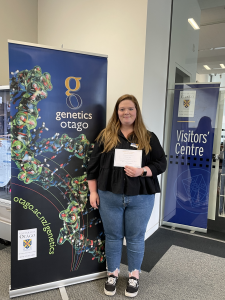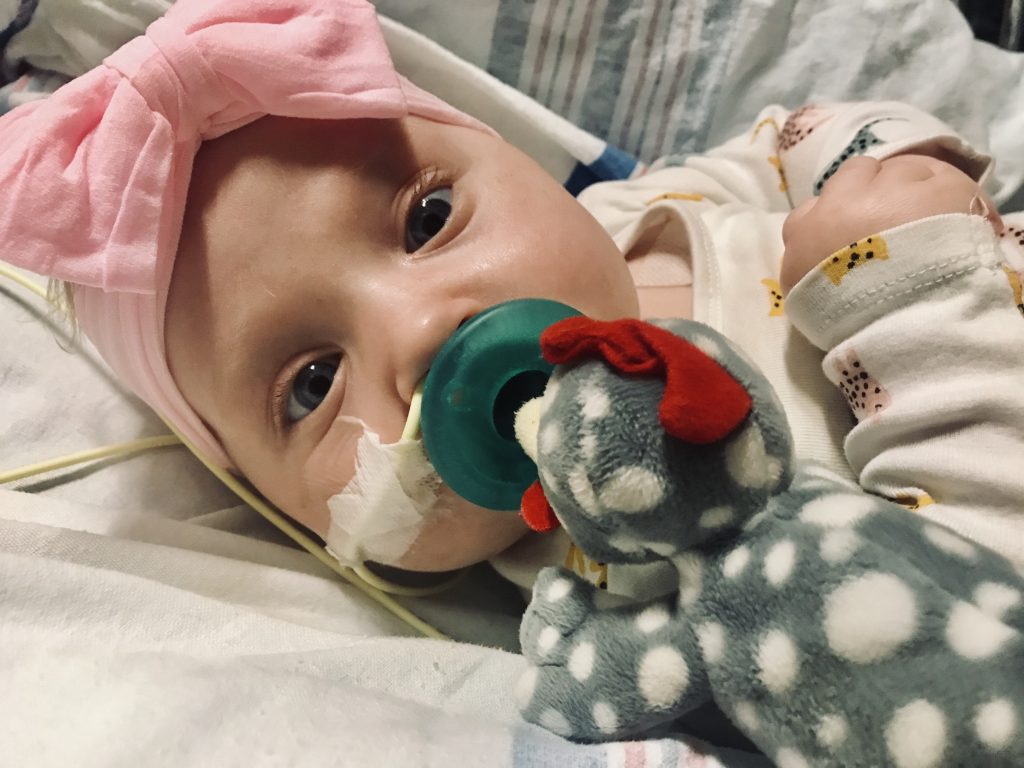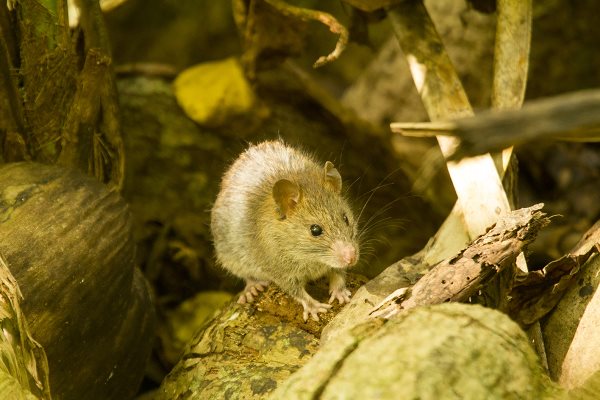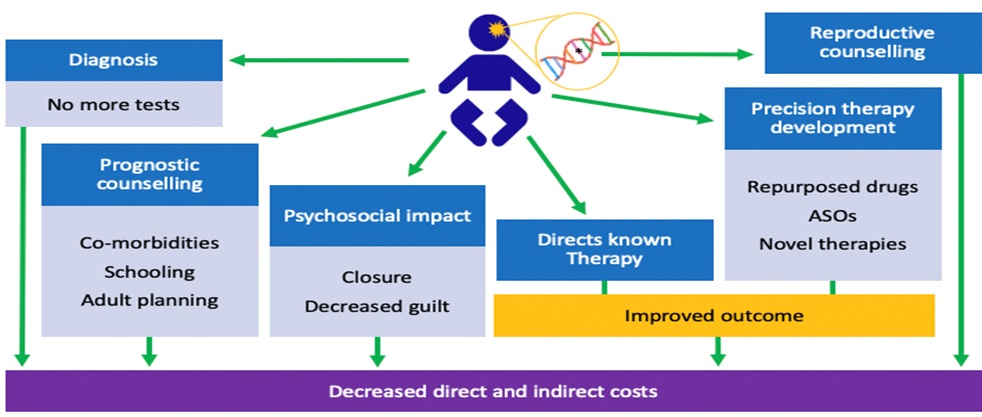DNA reveals history of Aotearoa’s manu
Pascale Lubbe, a PhD candidate in the Department of Anatomy, and Genetics Otago member is the lead author of a paper detailing the evolutionary history of kōkako, huia, and tīeke saddlebacks which were previously shrouded in mystery.
Read more in the University of Otago media release
Publication Details:
Mitogenomes resolve the phylogeography and divergence times within the endemic New Zealand Callaeidae (Aves: Passerida)
Pascale Lubbe, Nicolas J. Rawlence, Olga Kardailsky, Bruce C. Robertson, Robert Day, Michael Knapp, Nicolas Dussex
Zoological Journal of the Linnean Society
Trial of world-first gene therapy for Batten disease
Genetics Otago researcher, Associate Professor Stephanie Hughes and her team have been involved in a breakthrough gene-therapy treatment trial for children diagnosed with Batten disease.
Read more in the University of Otago media release
Genetics Otago researchers receive over $8 million in HRC funding
10 Genetics Otago members have collectively gained over $8 million in Health Research Council funding as lead and co-investigators in 2022 projects:
- Associate Professor Keith Ireton (General Project Grant), ‘Role of polarized exocytosis in infection of host cells by pathogenic E. Coli’, $1,199,984.
- Dr Matthew McNeil (General Project Grant), ‘Targeting metabolic dysregulation to eradicate drug resistant M. Tuberculosis’, $1,199,544.
- Professor Stephen Robertson (Dr Laura Gumy & Associate Professor Phillip Wilcox CI’s)(General Project Grant), ‘Bringing precision to the diagnosis of complex neurodevelopmental disorders’, $1,199,831.
- Associate Professor Logan Walker (Dr Vanessa Lau CI) (General Project Grant), ‘Improving genetic health through RNA diagnostics’, $1,190,889.
- Associate Professor Michael Black (CI) (General Project Grant), ‘A single-cell transcriptomic approach to gastric cancer heterogeneity’, $1,199,413.
- Professor Julia Horsfield (CI) (General Project Grant), ‘WNT signalling – a matter of degradation’, $1,199,533.
- Dr Allamanda Faatoese (CI) (General Project Grant), ‘Understanding the impact of ruralityon health outcomes and healthcare delivery’, $1,199,916.
Read more on the University of Otago Bulletin Board.
Cell biology discovery opens doors for brain disease research
Genetics Otago members Professor Stephen Robertson and Genetics Mātai Ira alumnus Dr Adam O’Neill are part of a group who have discovered how and why some genetic mutations can contribute to the cause of diseases like autism and brain malformations.
Read more in the University of Otago media release
Publication details:
Spatial centrosome proteome of human neural cells uncovers disease relevant heterogeneity
Adam C O’Neill, Fatma Uzbas, Giulia Antognolli, Florencia Merino, Kalina Draganova, Alex Jack, Sirui Zhang, Giorgia Pedini, Julia P Schessner, Kimberly Cramer, Aloys Schepers, Fabian Metzger, Miriam Esgleas, Pawel Smialowski, Renzo Guerrini, Sven Falk, Regina Feederle, Saskia Freytag, Zefeng Wang, Melanie Bahlo, Ralf Jungmann, Claudia Bagni, Georg H H Borner, Stephen P Robertson, Stefanie M Hauck and Magdalena Gotz
Science: DOI: 10.1126/science.abf9088
$500,000 for Otago gastric cancer research
Genetics Otago member, Dr Silke Neumann has received $250,000 from the Health Research Council’s Emerging Researcher First Grants for the project ‘Treating gastric cancer according to its biology’
Project Details:
Cancers originating from the same anatomical location often display distinct characteristics, which influence their interaction with the immune system, the success of treatments and patient survival. Gastric cancer, treated currently as one disease, displays two main histological forms. We have identified two genes encoding an immunoproteasome regulatory subunit, that impact stomach cancer survival in opposite ways in the two histological forms.
We will determine how these genes tip the balance between anti–tumour immunity and cancer progression and how exploiting these genes may improve patient outcomes in both types of gastric cancer. We will use a novel gene tagging technology to establish where in the cell immunoproteasome regulatory subunit genes and proteins are expressed and can be targeted therapeutically. Overall, our goal is to decipher the mechanism behind the opposing effects these genes play in cancer progression and how they could be exploited to improve survival from gastric cancer.
Read more on the University of Otago Bulletin Board
DNA provides unique look at moa and climate change
Genetics Otago members Dr Alex Verry, Dr Keiren Mitchell and Dr Nic Rawlence have used ancient DNA to provide new insight into the distribution of the extinct eastern moa altered their distribution in response to climate change.
Read more in the University of Otago media release and in the publication below.
Publication details
Genetic evidence for post-glacial expansion from a southern refugium in the eastern moa (Emeus crassus)
Alexander J F Verry, Kieren J Mitchell, Nicolas J Rawlence
Biology Letters
The Claire Aldrich Legacy
The world seems so big at times and at others so small. How could the death of a beautiful baby girl in the USA possibly have an impact on the young people of Aotearoa, half a world away? But it can. Thanks to a generous donation to Genetics Otago by the Aldrich Family who tragically lost their daughter, Claire, to an unknown rare genetic disease at only 8-months old, we have established ‘The Claire Aldrich Legacy’.
“Claire Elizabeth Aldrich was born into this world on April 14th, 2019 – in Charlotte, North Carolina. She was just perfect” says her mother, Sally. Sadly, at 7-months old Claire suffered a seizure that saw her referred to a paediatric neurologist for assessment. Claire never made it to this appointment because she was later admitted to the hospital with a respiratory illness which led to more seizures. An MRI scan showed significant deterioration of her brain and Claire tragically passed away on January 7th, 2020.
Genetic tests revealed that Claire had a mutation in HIVEP2 which explained some symptoms she had experienced prior to the seizures but it was determined that this was not the cause of her death. The geneticist working with the family speculated that there was a second rare mutation that led to Claire’s death but he could not provide an answer for the family. “As a parent, that lack of closure is so hard to live with,” Sally says, “It is a little bit embarrassing to admit, however before Claire, I naively thought that when it came to genetics, most, if not everything, was ‘discovered’. And now I know how wrong I am. There is so much to learn. So much to find.”
Sally and her husband Jeff along with their three children are moving to Dunedin later this year and they wanted to bring Claire with them in some way. So, they have made a donation to Genetics Otago to start ‘The Claire Aldrich Legacy’ a fund that will be used to grow our outreach efforts, helping to educate the next generations of budding scientists about the importance of genetic research. The fund will have a particular focus on rare disease genetics and the impact these diseases have on people’s lives.
“My wish for the Claire Aldrich Legacy is to help inspire the young minds of New Zealand. The leaders of tomorrow. In our high school years, we are still finding ourselves. I want students to know that they can make a real difference in the world. They can make life-changing discoveries. If I can share Claire’s story, maybe, just maybe, it might plant that seed that could one day grow into ground-breaking findings.” – Sally Aldrich, Claire’s Mother.
You can read more about Claire’s story and about The Claire Aldrich Legacy in the Washington Post.
Donations to the fund are being accepted through the University of Otago Donations page here.
World Rat Day – 4th April 2022
World Rat Day, yes it is a real thing, was founded 20 years ago by a group that loved their pet rats! Their aim was to challenge the stigma surrounding these creatures and promote their welfare. Dr Catherine Collins (Department of Anatomy, University of Otago) uses ancient DNA (aDNA) to better understand population origins and changes in human populations through time. Here she tells us about her work with the Kiore, and its importance to our understanding of how the Pacific, including Aotearoa, was settled by humans.
The kiore, or Pacific Rat (Rattus exulans), is the smallest of the three rat species found in Aotearaoa (R. exulans, Rattus norvegicus, and Rattus rattus). Today, kiore are the third most widely distributed Rattus species, and are distributed from mainland Southeast Asia, through Island Southeast Asia and throughout the Pacific1. Skeletal remains from kiore first appear in the Pacific, in Remote Oceania in archaeological sites of Lapita settlements and are found in many Lapita, and later Polynesian, archaeological sites in the Pacific2.
Kiore were introduced to Aotearoa around 1280C3, and were the only rat species present here until the introduction of the Norway (R. norvegicus) and Ship rats (Rattus rattus) in the late 18th century. Since the spread of Norway and Ship rats, kiore are now limited to parts of Fiordland, Southland and south Westland, and 18 offshore islands4. Kiore have been eradicated from many offshore islands that they previously inhabited, as part of pest eradication efforts. However, they are also considered to be taonga by some Māori. Consequently, kiore are protected, with Ngātiwai as kaitiaki, on the islands of Mauitaha and Araara off the coast of Northland5. As kiore are taonga, I am fortunate to work with iwi from across Aotearoa to learn more about kiore.

A kiore femur from a Pacific archaeological site – we would use about half of this bone to extract DNA from with current protocols.
Kiore are poor swimmers, so cannot settle new islands without some assistance – their present day distribution is a result of kiore being carried in the waka of people as they settled islands in the Pacific. Kiore were not the only animals that were introduced to Pacific islands in this way; kuri (Pacific dog), chickens and pigs, along with many plant species, were also important to Pacific peoples and transported with them to new islands. This relationship between kiore and humans means that by studying the genomics of kiore, we can further develop our understanding of the settlement of the Pacific, and ultimately Aotearoa. Matisoo-Smith et al.6 first applied the ‘commensal model’ to the Pacific, by studying a short region of mitochondrial DNA of kiore, to understand the relationships between kiore of different islands. Similarities and differences in genetic sequences of kiore from different islands in the Pacific can tell us how likely it is that those populations are related to one another. This data can then be used to inform hypotheses about the origin of the people in the same waka as the kiore. Genomic data from kiore alone is not sufficient to draw conclusions about these settlement processes, but when interpreted alongside human and other commensal genomic data, archaeological and linguistic data, and indigenous knowledge, we can begin to build a holistic hypothesis about the settlement of this region.
To obtain this data, I sequence DNA extracted from both modern kiore and archaeological kiore bones. The ancient DNA (aDNA) from kiore bones gives us some insight into a ‘snapshot’ in time in the past. With laboratory and sequencing technologies these days we can sequence complete mitochondrial genomes and nuclear markers (or complete nuclear genomes) from both the modern and ancient kiore. This gives us a much higher resolution dataset than what was previously available. You can think of it as the difference between only having a few pieces of a jigsaw puzzle versus having all of the pieces.
Written By Dr Catherine Collins
References:
4. Wilmshurst JM, Ruscoe WA. 2021. Rattus exulans. In The Handbook of New Zealand Mammals. 3rd edn. (Eds CM King and DM Forsyth) Family Muridae, pp. 161-240. CSIRO Publishing, Melbourne.
5. Department of Conservation (2010) DOC and Ngatiwai Trust Board sign management agreement for two of the Marotere (Chicken) Islands http://www.doc.govt.nz/news/media-releases/2010/doc-and-ngatiwai-trust-board-sign-management-agreement-for-two-of-the-marotere-chicken-islands.
Epilepsy Awareness Day 26th March 2022 – Research Highlight
Who are you?
The Epilepsy Research Group, led by Professor Lynette Sadleir, is a research team based in the Paediatrics department of the University of Otago, Wellington. Professor Sadleir is a paediatric epileptologist at Wellington Children’s Hospital, as well as being the director of our group and heavily involved in epilepsy research. The team consists of our bioinformatician, research assistants, and PhD students.
What is the main objective of your research?
In the Epilepsy Research Group, our main objective is to improve the quality of life for people who have epilepsy. We undertake research that aims to understand the spectrum of epilepsy syndromes and their underlying genetic causes. Currently, we are particularly focused on the most severe group of epilepsies: developmental and epileptic encephalopathies. In these catastrophic disorders that present in childhood, the seizures and ongoing abnormal brain activity between seizures cause brain damage and result in intellectual disability, physical disability, autism and behavioural problems. We aim to use clinical and genetic approaches to identify new and emerging epilepsy syndromes in these children and then sequence their DNA to identify the genes responsible. When we identify novel epilepsy genes, we can then define the clinical presentation of people who have genetic abnormalities in those genes. Our findings are quickly put into clinical practice and help with the diagnosis and management of children who present have these severe disorders.
How is Genetics important to the research?
Epilepsy has a variety of causes however, the majority of epilepsy is caused by changes in the genetic code of an affected individual. These genetic changes cause abnormalities in the way the brain functions which ultimately result in seizures. There are a multitude of benefits that come with identifying the genetic change causing an individual’s epilepsy, which help improve the lives of children with epilepsy and their families.
Why should others be interested in your work?
Epilepsy is the most common serious neurological disorder worldwide. It is characterised by recurrent, unpredictable seizures. Over a lifetime, 1 in 20 people will have a seizure and ~38, 000 New Zealanders will be diagnosed with epilepsy. Epilepsy is a group of disorders, each with varying seizure types and outcomes. Many individuals live a relatively normal life but one third have treatment-resistant seizures which negatively impact their quality of life. The developmental and epileptic encephalopathies, in particular, can have a devastating impact on the trajectory of a child’s life. Our work, therefore, has the potential to help those individuals who are seriously impacted by their seizures.
Written by Brittany Jones
Science communication key to leading the research narrative, GO Symposium award winner says

Victoria Sugrue, University of Otago PhD candidate in Anatomy, is the winner of the People’s Choice Science Communication award at the recently held Genetics Otago Symposium, for a video about her research on the effect of sex hormones on DNA methylation.
Lab Supply was the sponsor of the annual event, which showcased and recognised the latest research from across the Centre. Lab Supply also sponsored the Science Communication prize, which highlights the value of communicating science in a way that informs and inspires audiences.
Read the full article and learn more about Victoria’s research here.
Congratulations Victoria!
Republished with permission. This story was first published by Lab Supply.






